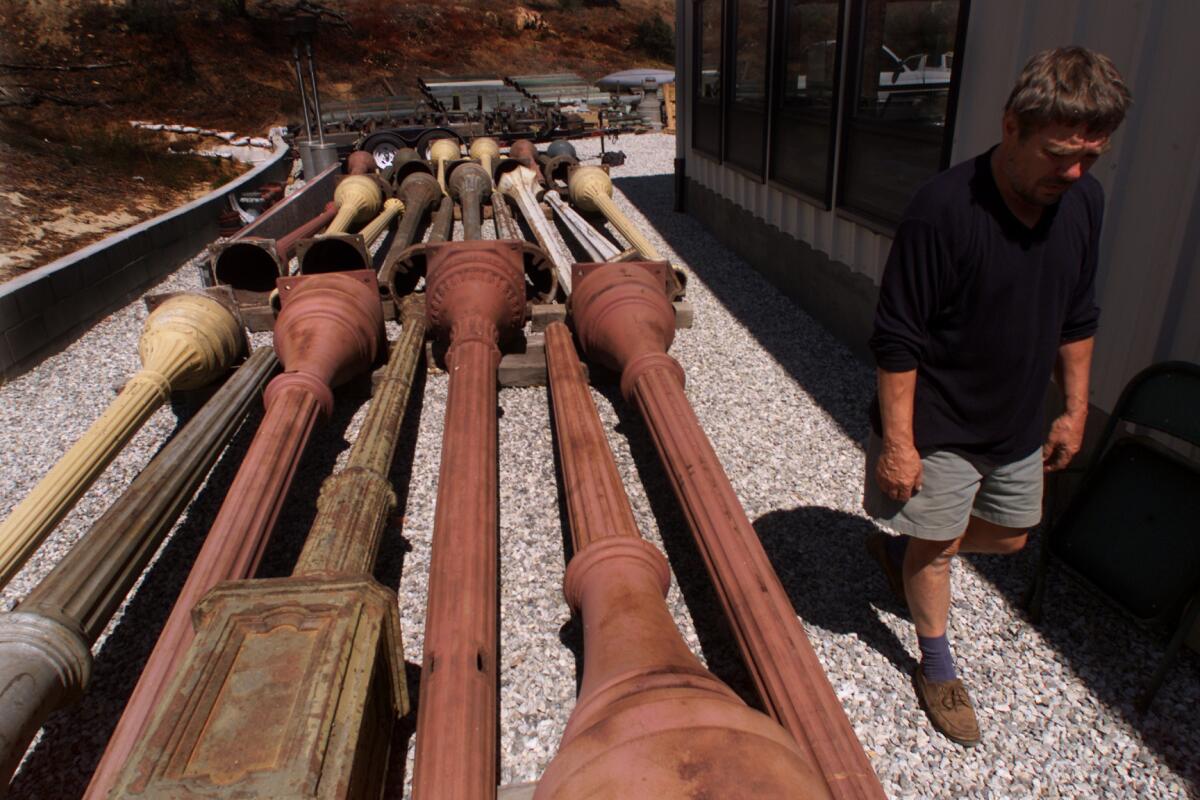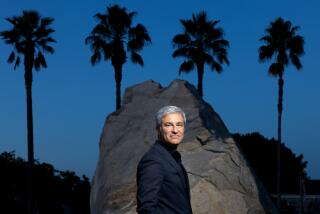Chris Burden’s roundabout route of bringing ‘Urban Light’ to L.A.

Artist Chris Burden collected and restored dozens of city street lamps at his Topanga Canyon studio. Eventually they became his installation at
- Share via
The last time I formally interviewed Chris Burden was on the eve of the unveiling of “Urban Light” in early 2008. I was on assignment for this newspaper, and we met on a dreary winter day on the plaza of the Los Angeles County Museum of Art alongside the now-iconic installation of 202 vintage Los Angeles street lamps.
Workmen were still wiring the lamps as we sat down, and there was a bit of tension as to whether they would finish in time for the scheduled first lighting. Burden was clearly tense that day, and when I pulled out my tape recorder — as I’d done with him dozens of times before — he immediately told me to turn it off.
“Take notes,” he said, not particularly kindly, explaining that he hated to read his quotes exactly as he’d spoken — the reverse of most interview subjects. I gulped and started scribbling, knowing full well that I had hours of him talking on tape about these same lamps already in my files at home. We both knew that.
Burden, who died May 10 at age 69, was like that. You thought you were on a path together, and suddenly he’d take a sharp turn that threw you off balance. He was both particular and unpredictable. I asked whether the lamps were being lighted with solar power, which a member of the museum staff had suggested. He said angrily that he had no interest in being green; the work was about art and light and history.
I changed the subject. He warmed up.
“I’ve been driving by these buildings for 40 years, and it’s always bugged me how this institution turned its back on the city,” he said of LACMA, the money quote that led the story. Quintessential Burden — always an engineer or architect in his heart. If something bothered him, he wanted to fix it. He predicted the lamps would reinvent the museum’s image and also restore life to a piece of L.A. history. He could not have proved more prescient.
He’d been obsessed with those lamps since December 2000. In 2003, he’d shown me the receipt for $1,600 for his first purchase, of two, at the Rose Bowl Flea Market. (He kept meticulous records of everything.) At first he’d imagined putting them at the end of his driveway. “Then when I got more and more of them,” he said. “I started to see the potential. And I really liked them, and it felt like I was buying a piece of a city. It felt like I was buying a city.”
As he delved into a world of collectors, he dug in deeper and deeper. “I had some cash coming in, and basically I turned all my profit into the lamps. … And to me that was a good investment, although who knows if it will be.”
From 2003 through 2005, I spent a good deal of time at his hilltop Topanga Canyon studio doing research for a biography I have yet to write. When I first visited, dozens of lamp carcasses were lying everywhere on the grounds, gutted of their electrical innards, mostly in pieces.
Once, when he’d just taken his first few to be repaired and repainted at a shop in the San Fernando Valley, he led me there, down the winding hill from the studio — I followed his truck in my car, and I remember distinctly the care he took to make sure I wouldn’t get lost. He often offered a mix of deep personal concern combined with a somewhat distant, arm’s-length nonchalance.
At the shop, four of the shorter lamps were installed, slim and elegant and brightly lighted, already coated in the gray powder-coat paint that would become his signature — he had no interest in mimicking their original green. I earned his attention, if not respect, that day as I grilled the shop’s foreman about the paint’s application and durability. Burden liked technical discussions.
In his studio and in his home, he often seemed as much a collector as an artist. His workspace was always full of detritus, only some of it in use. Cars, trains, Erector sets and boxes of Lincoln Logs were piled high, in addition to the artworks he was working on with the help of a host of studio assistants. Even as he was thinking about the lamps, his team was developing the first iteration of what would become “Metropolis,” the racetrack of moving mini-cars in and around a simulated city, a version of which, “Metropolis II,” also is at LACMA. It was all serious play.
At one point, he thought the lamps might sell to MAK Vienna, the Austrian museum of applied arts where he’d had a retrospective. He talked a lot about “moving L.A. to Europe,” bringing West Coast light to the old country. The reversal of art’s hierarchy amused him. But the cost of moving the lamps became prohibitive.
And then there was a plan was to take them to New York’s Gagosian Gallery and spread them around on the city’s streets, which also ultimately fell through. It was a couple of years after 9/11, and he imagined they’d bring “life and light back to the city.”
Many months passed, and with it much frustration and spilled ink in angry letters over the canceled plans, but finally Burden decided to take things into his own hands and show the work in his own way, at his own studio.
He installed dozens of the lamps, two-by-two, onto newly laid and electrified concrete pads surrounding the outside of his airplane hangar-like workspace toward the end of 2005. Then he and his wife, the accomplished and prolific sculptor Nancy Rubins, threw a party at which he threw the switch, and the lights went on. It was spectacular. The neighbors must have done a double-take at the sight.
Around this time LACMA got involved. Museum Director Michael Govan’s and senior curator of modern art Stephanie Barron’s vision and commitment to bringing 202 of those lamps to Wilshire Boulevard must be acknowledged, not least because the lamps had to be transported down a tight, switchback road from the studio. And that was just the start of the complex task of installing them and making those streetlights public again.
There is another satisfying element. Museums are meant to preserve, and Burden cared about legacy. “These lamps were designed to last several hundred years,” he told me in one conversation. “This lamp will last 10,000 years. ... It’s such a weird idea, to make an object that is designed to be around for several thousand years. Nobody ever thinks in those terms anymore. At all. Do you know what I’m saying?”
We moved on to talk about some sculptures of metal suspension bridges he was working on at the time. “Those bridges could be around in a couple hundred years. Long after I’m gone. They have the potential, if somebody takes care of them. I just like the fact that I’m making something that could physically outlast me by a significant amount.”
Susan Freudenheim is executive editor of the Jewish Journal.
More to Read
The biggest entertainment stories
Get our big stories about Hollywood, film, television, music, arts, culture and more right in your inbox as soon as they publish.
You may occasionally receive promotional content from the Los Angeles Times.










